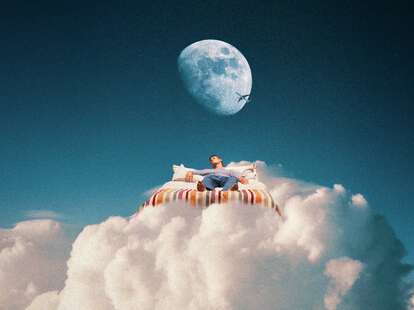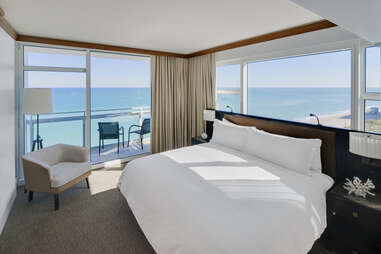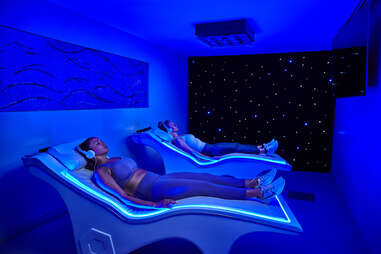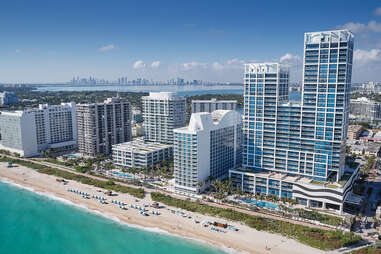
Travel from A to Zzz on a Sleep Retreat
When it comes to a good night’s rest, the travel industry is going all in.
As the largest spa and wellness resort on the East Coast, the Carillon Miami clocks in at 70,000 square feet. Its luxe magnitude is enhanced only by an all-suite layout, with floor-to-ceiling windows that showcase the gentle, lapping waves of a vast turquoise ocean. But I’m here for a bed.
The bed in question is manufactured by Bryte, and it’s now available in luxury hotels around the country aiming to capitalize on the sleep tourism trend. Choose your preferred firmness and, utilizing symmetrical air pockets that inflate and go limp with bodily pressure, it adjusts accordingly for maximum comfort throughout the night, giving you, allegedly, the most restorative sleep of your life.
After my first night, I’m emailed a report detailing the stats of my slumber: how much I actually slept (seven hours and 33 minutes), how much of that was REM (13 minutes… yikes), my average heart rate (you don’t want to know), and more. Think an Oura Ring, but the actual bed does the work—the next logical step in AI-enhanced sleep optimization. The bed can even be your own personal wellness guru. Through a proprietary technology called Somnify, you’re able to select from a menu of audio meditations or soothing sounds, each synced to corresponding full-body massages. It can do everything from leading you in focused breathing exercises to playing gratitude mantras to plopping you in the middle of a simulated thunderstorm.
In a survey by Hilton, a top trend for 2024 travel is sleep. In 2019, the global sleep economy was valued at about $432 billion; by next year, it will reach $585 billion. And though sleep retreats have been around for quite some time now, this recent bump in growth has been aided, at least in part, by the COVID-19 pandemic, which shed light on the impact of sleep on overall health. Over three nights at Carillon, I’ll join the thousands of people who have now traveled specifically to catch some z’s.

Think of a slogan pertaining to sleep, and you’ll find they all glorify the grind: “No sleep for the weary,” “I’ll sleep when I’m dead,” “Sleep is for the weak.” It’s a sentiment Equinox Hotels CEO Chris Norton knows all too well. “Years ago, I would travel 210 days a year, and I was so proud that I could make it on four or five hours of sleep a day,” he says. “I would brag about it, which is hard to believe because your brain is active [when you’re asleep], sometimes more than when you’re awake. The saying ‘I'll sleep when I'm dead’ is so off the mark.”
When the Equinox Hotel in Manhattan’s Hudson Yards opened in 2019, Norton knew he wanted to focus on slumber. And that plan has since paid off. “We’ve found the most common comment from guests is ‘I never want to leave,’” he says. “We’ve designed the entire guest room around the pillar of recovery and sleep—we got interior designers, but we also hired psychologists and scientists to help incorporate the perfect environment.”
“The saying ‘I'll sleep when I'm dead’ is so off the mark.”
At Equinox Hotel, rooms are soundproofed and fit with blackout shades, thermostats, and lighting fixtures controlled by a bedside tablet. Flip on for the one-stop Dark Quiet Cool mode, and be rewarded with what has been deemed the optimal sleep environment (66 degrees Fahrenheit, in case you were wondering). The sheets contain cooling natural fibers, beds come without springs or other mechanisms, and the bedding makeup utilizes the “Scandinavian sleep method” (each sleeper gets their own comforter, so no one can steal the covers).
The brand also offers sleep retreat packages like The Art + Science of Sleep by Equinox Hotels. Designed to reset a guest’s circadian rhythm, the program leans on biohacking with cryotherapy, hot and cold plunges, and the Spa Wave Table, which promises three hours of sleep in just 30 minutes. And like Carillon’s program, it’s also intended to arm guests with tools to replicate their experience at home, providing them with everything from deep-breathing techniques from an in-house sleep coach to exactly how and where to drop $6,299 on their own Bryte Bed.
“We wanted to highlight the fact that sleep is important,” says Norton. “Because besides the science, there’s also an attitude adjustment needed towards sleeping and resting. It’s not just about blacking out.”

The Sleep Well Retreat at the Carillon is a mix of high- and low-tech—apt, as sleep technology has grown alongside the burgeoning field of sleep science, which itself is about only 15 years old. And as it happens, Bryte also funds quite a bit of research. The weekend I’m at the retreat, lectures are helmed by Harvard researcher Dr. Rebecca S. Robbins, a leader in the field and, if you tune into daytime television, the new face of sleep. Through their work, scientists like Robbins, who also co-authored the book Sleep for Success!, are finding that less sleep may, in fact, be deadly. As it stands, a third of the US population admits to not getting enough rest. But they’re finally waking up to the fact that not getting the World Health Organization’s recommended eight hours of sleep per night—quality, REM-inducing sleep—can contribute to problems like obesity, hypertension, stress, slower cognitive function, cancer, and other concerning health conditions.
Robbins’s goal is to get the word out. When she’s not spreading the gospel at high-end resorts at sumptuous sleep retreats (the Carillon’s starts at $2,598 for a four-night stay), she’s researching the effects of sleep deficiency on quality of life in subjects like college students, caregivers, taxi drivers, and other underserved communities. So far, however, the sleep-retreat community is very… served. And, as it turns out, incredibly technophilic. For someone whose ancient iPhone threatens to off itself daily, it can be a bit overwhelming, and treatments only highlight the current barriers to access.
At the Carillon, my lectures are supplemented with touchless wellness technology at the hotel’s spa. This includes futuristic contraptions like V.E.M.I., or Vibroacoustic Electro Magnetic and Infrared Therapy, where I lay on a vibrating lounge designed to catapult me into a deep meditative state; or the Somadome, which immerses me in a combination of sound, light, and guided meditations while I’m locked inside a Pac-Man-like pod the size of a smart car (I’m assured that if I get claustrophobic, I can push it open from the inside). Each evening, the effectiveness of these tools is put to the test via the easiest exam possible: nodding my head and getting some sleep.
For my first night, I opt for the thunderstorm option on my Bryte Bed, a surreal mix of natural sounds projected through a high-tech lens. A well-rested person should take 20 minutes to fall asleep. According to my report, it takes me 56.

Despite my best efforts, my sleep scores remained dismal over the course of my stay at the Carillon. It’s not you, Bryte Bed, it’s me—after all, a history of poor sleeping habits brought me to the retreat in the first place. But thanks to Robbins’s lectures, I did come away with some tips for getting that optimal seven to nine hours at home—strategies like erecting blackout curtains, creating a relaxing nighttime routine, limiting caffeine and alcohol near bedtime, and avoiding the three s’s: screens, social media, and scary news (good luck). These tips and more can also be found in her book, which is available in some places at a far more accessible price of $5.
Perhaps we’ll find that the best thing that can come of the rise of luxury-sleep tourism is a renewed focus on the importance of sleep itself—fancy pod and thunderstorm-inducing bed aside. For me, a good night’s sleep in my own bed is all the luxury I need.